Poetry, often considered the most expressive form of writing, uses language in unique and compelling ways to evoke emotions, create imagery, and convey deep meanings. However, understanding poetry requires more than just reading the lines; it involves grasping the various literary devices, forms, and structures that poets use to craft their works. This guide will explore 50 of the most common American poetry terms, providing clear definitions, phonetic transcriptions, and practical examples.
Whether you’re a student, a poetry enthusiast, or someone looking to enhance your literary knowledge, becoming familiar with common poetry terms can deepen your appreciation and interpretation of poems.
Table of Contents
- 50 Essential Poetry English Terms Every Student Must Know
- #1. Alliteration 🌀
- #2. Assonance 🎵
- #3. Metaphor 🔥
- #4. Simile ✨
- #5. Onomatopoeia 💥
- #6. Personification 🌳
- #7. Imagery 🌅
- #8. Symbolism 🕊️
- #9. Hyperbole 🌟
- #10. Irony 🙃
- #11. Rhyme Scheme 🎼
- #12. Free Verse 🖋️
- #13. Sonnet 💕
- #14. Enjambment 🏃
- #15. Stanza 📖
- #16. Meter 🎵
- #17. Couplet 👫
- #18. Quatrain 📜
- #19. Haiku 🌸
- #20. Sestina 🔁
- #21. Blank Verse 🎭
- #22. Ode 🏺
- #23. Elegy 🌹
- #24. Limerick 🎉
- #25. Ballad 🎤
- #26. Villanelle 🌻
- #27. Anaphora 🔁
- #28. Epistrophe 🔄
- #29. Apostrophe ✍️
- #30. Caesura ✂️
- #31. Consonance 🌀
- #32. Diction 🗣️
- #33. Euphony 🎶
- #34. Cacophony 🔊
- #35. Allusion 📚
- #36. Paradox 🌀
- #37. Oxymoron ⚡
- #38. Metonymy 🔄
- #39. Synecdoche ✋
- #40. Anachronism ⏳
- #41. Tercet 📝
- #42. Volta 🌀
- #43. Allegory 🌈
- #44. Hyperbole 💥
- #45. Litotes 🌿
- #46. Imagery 🎨
- #47. Juxtaposition ⚖️
- #48. Irony 😲
- #49. Sarcasm 😜
- #50. Understatement 🤫
- Poetry English Terms Table
- Conclusion
50 Essential Poetry English Terms Every Student Must Know
By learning these terms, you’ll be able to analyze poems more effectively and enjoy the nuances that make poetry a powerful art form. So, let’s dive into the world of American poetry and discover the language that makes this genre so rich and diverse. 📚✨
#1. Alliteration 🌀
Definition: Alliteration is the repetition of the same initial consonant sounds in a series of words. This device is often used to create rhythm and mood, emphasizing particular words or themes within the poem.
Phonetic Transcription: /əˌlɪtəˈreɪʃən/
Examples:
- She sells seashells by the seashore.” – This classic example shows how the repetition of the ‘s’ sound mimics the sound of the sea, enhancing the poem’s imagery.
- “Peter Piper picked a peck of pickled peppers.” – Here, the repetition of the ‘p’ sound creates a playful rhythm, making the line memorable and engaging.
#2. Assonance 🎵
Definition: Assonance is the repetition of vowel sounds within a line or passage of poetry. Unlike alliteration, which focuses on consonant sounds, assonance emphasizes vowel sounds, contributing to the poem’s musicality and mood.
Phonetic Transcription: /ˈæsənəns/
Examples:
- “Hear the mellow wedding bells.” – The repetition of the ‘e’ sound in ‘mellow’ and ‘wedding’ creates a soothing, harmonious effect, enhancing the poem’s celebratory tone.
- “The early bird catches the worm.” – The use of the ‘ea’ sound in ‘early’ and ‘bird’ provides a rhythmic quality that makes the phrase catchy and easy to remember.
#3. Metaphor 🔥
Definition: A metaphor is a figure of speech that describes one thing as if it were another, highlighting similarities between the two without using “like” or “as.
Phonetic Transcription: /ˈmɛtəˌfɔr/
Examples:
- Time is a thief.” – This metaphor suggests that time steals moments from our lives, emphasizing the fleeting nature of life.
- The world is a stage.” – This famous metaphor from Shakespeare implies that life is like a play, with each person playing a role, highlighting the performative aspects of human behavior.
#4. Simile ✨
Definition: A simile is a figure of speech that compares two different things using the words “like” or “as” to highlight their similarities.
Phonetic Transcription: /ˈsɪməli/
Examples:
- “Her smile was as bright as the sun.” – This simile compares the brightness of her smile to the sun, emphasizing its warmth and positivity.
- “He fought like a lion.” – Comparing his fighting style to a lion’s bravery and strength, this simile underscores his courage and fierceness.
#5. Onomatopoeia 💥
Definition: Onomatopoeia refers to words that imitate the natural sounds associated with them, often used in poetry to create a vivid sensory experience for the reader.
Phonetic Transcription: /ˌɒnəˌmætəˈpiə/
Examples:
- “The bees buzzed in the garden.” – The word “buzzed” imitates the actual sound bees make, enhancing the auditory imagery of the poem.
- “The thunder boomed and the lightning cracked.” – The words “boomed” and “cracked” mimic the sounds of a thunderstorm, adding to the poem’s dramatic effect.
#6. Personification 🌳
Definition: Personification is a literary device where human qualities are attributed to non-human objects or abstract ideas, making them more relatable and vivid.
Phonetic Transcription: /pərˌsɒnɪfɪˈkeɪʃən/
Examples:
- “The wind whispered through the trees.” – The wind is given the human ability to whisper, creating a sense of quiet and mystery.
- “The sun smiled down on us.” – By personifying the sun as smiling, the poet conveys a feeling of warmth and happiness.
#7. Imagery 🌅
Definition: Imagery involves using vivid and descriptive language to create mental pictures or sensory experiences for the reader, engaging their imagination and emotions.
Phonetic Transcription: /ˈɪmɪdʒəri/
Examples:
- The crimson petals of the rose fell softly to the ground.” – This imagery evokes a visual scene of a red rose losing its petals, enhancing the poem’s emotional impact.
- “The aroma of freshly baked bread filled the air.” – This example appeals to the sense of smell, making the reader almost feel the presence of freshly baked bread.
#8. Symbolism 🕊️
Definition: Symbolism is the use of symbols to represent ideas or qualities, giving deeper meanings to objects, events, or characters beyond their literal sense.
Phonetic Transcription: /ˈsɪmbəˌlɪzəm/
Examples:
- “A dove flew overhead, signifying peace.” – The dove symbolizes peace, often used to represent tranquility and harmony.
- “The dark clouds gathered, foreshadowing trouble.” – The dark clouds symbolize an impending threat or conflict, enhancing the poem’s mood.
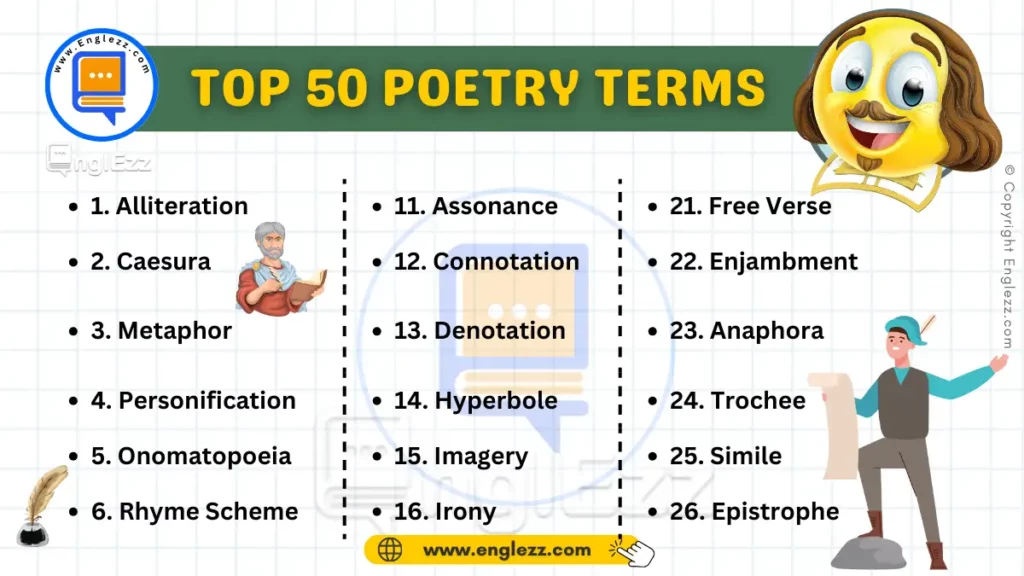
#9. Hyperbole 🌟
Definition: Hyperbole is a figure of speech that involves exaggerated statements or claims not meant to be taken literally, used to emphasize a point or evoke strong feelings.
Phonetic Transcription: /haɪˈpɜrbəli/
Examples:
- “I’m so hungry I could eat a horse.” – This exaggeration emphasizes extreme hunger, not to be taken literally.
- “I’ve told you a million times.” – This hyperbole highlights frustration or emphasis, exaggerating the number of times something has been said.
#10. Irony 🙃
Definition: Irony is a literary device where the actual meaning is opposite to the literal meaning, often used to create humor, emphasize a point, or express criticism.
Phonetic Transcription: /ˈaɪrəni/
Examples:
- “A fire station burns down.” – This is ironic because one would expect a fire station to be immune to fires, highlighting an unexpected outcome.
- “The world’s most famous chef is eating instant noodles.” – This irony contrasts the chef’s reputation with his current action, creating a humorous effect.
#11. Rhyme Scheme 🎼
Definition: A rhyme scheme is the pattern of rhymes at the end of each line of a poem, usually described using letters to indicate which lines rhyme with each other.
Phonetic Transcription: /raɪm skiːm/
Examples:
- ABAB Rhyme Scheme: “The sun is bright / It warms the day / It’s such a sight / To watch it sway.”
- AABB Rhyme Scheme: “The cat sat on the mat / It didn’t like the rat / They both had a spat / Now, that’s that.”
#12. Free Verse 🖋️
Definition: Free verse is a type of poetry that does not follow any specific meter or rhyme scheme, allowing for greater freedom of expression.
Phonetic Transcription: /friː vɜrs/
Examples:
- The sun rises / slowly / over the horizon, / greeting a new day.
- “Water flows / gently / over the rocks, / whispering its song.”
#13. Sonnet 💕
Definition: A sonnet is a 14-line poem with a specific rhyme scheme and meter, often written in iambic pentameter.
Phonetic Transcription: /ˈsɒnɪt/
Examples:
- Shakespearean Sonnet: “Shall I compare thee to a summer’s day? / Thou art more lovely and more temperate.”
- Petrarchan Sonnet: “When I consider how my light is spent, / Ere half my days, in this dark world and wide.”
#14. Enjambment 🏃
Definition: Enjambment is a poetic technique where a sentence or phrase continues beyond the end of a line or stanza without a pause or break.
Phonetic Transcription: /ɪnˈdʒæmbmənt/
Examples:
- “The sky was full / of stars that night / as we walked, / holding hands.”
- “She ran to catch the bus / before it drove away.”
#15. Stanza 📖
Definition: A stanza is a grouped set of lines in a poem, often set apart from other groups by a space, forming a unit similar to a paragraph in prose.
Phonetic Transcription: /ˈstænzə/
Examples:
- “The sun is high / in the sky / birds fly by,” (Stanza 1) “The day is bright / in its light / all is right.” (Stanza 2)
- “The moon shines / in the night / stars give light,” (Stanza 1) “Waves crash / on the shore / forevermore.” (Stanza 2)
#16. Meter 🎵
Definition: Meter is the rhythmic structure of a line of poetry, determined by the number and types of stresses or beats in each line.
Phonetic Transcription: /ˈmiːtər/
Examples:
- Iambic Pentameter: “Shall I compare thee to a summer’s day?” (Five iambs per line)
- Trochaic Tetrameter: “Double, double, toil and trouble.” (Four trochees per line)
#17. Couplet 👫
Definition: A couplet is a pair of successive lines of poetry that usually rhyme and have the same meter.
Phonetic Transcription: /ˈkʌplɪt/
Examples:
- “The cat sat on the mat, / And that’s where it sat.”
- “I do not like green eggs and ham, / I do not like them, Sam-I-Am.”
#18. Quatrain 📜
Definition: A quatrain is a stanza or poem of four lines, often with alternating rhymes.
Phonetic Transcription: /ˈkwɒtreɪn/
Examples:
- “Hope is the thing with feathers / That perches in the soul, / And sings the tune without the words, / And never stops at all.”
- “The curfew tolls the knell of parting day, / The lowing herd wind slowly o’er the lea, / The plowman homeward plods his weary way, / And leaves the world to darkness and to me.”
#19. Haiku 🌸
Definition: A haiku is a traditional Japanese form of poetry with three lines, containing a 5-7-5 syllable structure, often focusing on nature or moments of beauty.
Phonetic Transcription: /ˈhaɪkuː/
Examples:
- “An old silent pond… / A frog jumps into the pond— / Splash! Silence again.”
- “Winter seclusion— / Listening, that evening, / To the rain in the mountain.”
#20. Sestina 🔁
Definition: A sestina is a complex form of poetry consisting of six stanzas of six lines each, followed by a three-line envoy, with a pattern of word repetition.
Phonetic Transcription: /sɛˈstiːnə/
Examples:
- “She weaves her stories with a thread of gold, / In every line, a tale of love untold, / A spinning wheel of fate, she spins the song, / Each verse a page in history so long, / The words like whispers in the cold night air, / A testament to everything that’s fair.”
- “Beneath the waves, the hidden treasures sleep, / Awaiting the brave soul who dares to seek, / In every ripple, there’s a secret deep, / The ocean speaks to those who dare to speak, / A dance of life beneath the calm blue tide, / Where dreams and reality collide.”
#21. Blank Verse 🎭
Definition: Blank verse is poetry written in unrhymed iambic pentameter, often used in English dramatic, epic, and reflective verse.
Phonetic Transcription: /blæŋk vɜrs/
Examples:
- “To be, or not to be, that is the question— / Whether ’tis nobler in the mind to suffer.”
- “And then he thinks he knows / The hills where his life rose, and the sea / Where it goes down.”
#22. Ode 🏺
Definition: An ode is a form of poetry that is lyrical in nature, often praising people, nature, or abstract ideas in a solemn and serious manner.
Phonetic Transcription: /oʊd/
Examples:
- “Ode to a Nightingale” by John Keats: “Thou wast not born for death, immortal Bird! / No hungry generations tread thee down.”
- “Ode on a Grecian Urn” by John Keats: “Heard melodies are sweet, but those unheard / Are sweeter; therefore, ye soft pipes, play on.”
#23. Elegy 🌹
Definition: An elegy is a mournful, melancholic poem, often lamenting the death of a person or reflecting on a tragic event.
Phonetic Transcription: /ˈɛlədʒi/
Examples:
- “O Captain! My Captain!” by Walt Whitman, which mourns the death of Abraham Lincoln.
- “In Memory of W.B. Yeats” by W.H. Auden, which reflects on the death of the poet Yeats.
#24. Limerick 🎉
Definition: A limerick is a humorous five-line poem with a specific rhythm and an AABBA rhyme scheme.
Phonetic Transcription: /ˈlɪmərɪk/
Examples:
- “There once was a man from Peru, / Who dreamed he was eating his shoe. / He woke with a fright / In the middle of the night / To find that his dream had come true.”
- “A fellow jumped off a high wall, / And had a most terrible fall. / He went back to bed, / With a bump on his head— / That’s why you don’t jump off a wall.”
#25. Ballad 🎤
Definition: A ballad is a narrative poem that tells a story, often of folk origin, typically composed of quatrains with an ABAB or ABCB rhyme scheme.
Phonetic Transcription: /ˈbæləd/
Examples:
- “The Rime of the Ancient Mariner” by Samuel Taylor Coleridge: “It is an ancient Mariner, / And he stoppeth one of three.”
- “The Ballad of Reading Gaol” by Oscar Wilde: “He did not wear his scarlet coat, / For blood and wine are red, / And blood and wine were on his hands / When they found him with the dead.”
#26. Villanelle 🌻
Definition: A villanelle is a 19-line poem with two repeating rhymes and two refrains, structured in five tercets followed by a quatrain.
Phonetic Transcription: /ˌvɪləˈnɛl/
Examples:
- “Do not go gentle into that good night” by Dylan Thomas: “Do not go gentle into that good night, / Old age should burn and rave at close of day; / Rage, rage against the dying of the light.”
- “One Art” by Elizabeth Bishop: “The art of losing isn’t hard to master; / So many things seem filled with the intent / To be lost that their loss is no disaster.”
#27. Anaphora 🔁
Definition: Anaphora is the repetition of a word or phrase at the beginning of successive lines or sentences in poetry or prose, used for emphasis.
Phonetic Transcription: /əˈnæfərə/
Examples:
- “We shall fight on the beaches, we shall fight on the landing grounds, we shall fight in the fields and in the streets, we shall fight in the hills; we shall never surrender.” – Winston Churchill
- Every day, every night, in every way, I am getting better and better.” – This repetition emphasizes determination and continuous improvement.
#28. Epistrophe 🔄
Definition: Epistrophe is the repetition of a word or phrase at the end of successive lines or sentences, often used to emphasize a concept.
Phonetic Transcription: /ɪˈpɪstrəfi/
Examples:
- “See no evil, hear no evil, speak no evil.” – The repetition of “no evil” emphasizes the avoidance of evil.
- “Where now? Who now? When now?” – The repetition of “now” creates a sense of immediacy and urgency.
#29. Apostrophe ✍️
Definition: Apostrophe is a literary device where a speaker directly addresses someone absent, an inanimate object, or an abstract concept as if it could respond.
Phonetic Transcription: /əˈpɒstrəfi/
Examples:
- “O death, where is thy sting? O grave, where is thy victory?” – The speaker addresses death and the grave as if they could answer.
- “Twinkle, twinkle, little star, / How I wonder what you are!” – The speaker addresses the star directly.
#30. Caesura ✂️
Definition: A caesura is a deliberate pause or break in a line of poetry, often marked by punctuation, used to create a rhythmic effect or to emphasize a point.
Phonetic Transcription: /siˈzjʊərə/
Examples:
- “To be, or not to be—that is the question.” – The dash creates a pause, adding dramatic effect.
- “The winds that will be howling at all hours, / And are up-gathered now like sleeping flowers.” – The comma creates a pause, adding rhythm and emphasis.
#31. Consonance 🌀
Definition: Consonance is the repetition of consonant sounds within or at the end of words in a line or passage, often used to create rhythm or emphasize words.
Phonetic Transcription: /ˈkɒnsənəns/
Examples:
- “The lumpy, bumpy road.” – The repetition of the “mp” sound creates a rhythmic effect.
- “I think I like the pink kite.” – The repetition of the “k” sound ties the words together.
#32. Diction 🗣️
Definition: Diction refers to the choice of words and style of expression used by a poet or writer, which affects the tone and meaning of the poem.
Phonetic Transcription: /ˈdɪkʃən/
Examples:
- Formal diction: “It is a truth universally acknowledged, that a single man in possession of a good fortune, must be in want of a wife.” – This choice of words reflects a formal tone.
- Informal diction: “What’s up, doc?” – This choice of words reflects a casual, conversational tone.
#33. Euphony 🎶
Definition: Euphony refers to the use of pleasant, harmonious sounds in poetry, often achieved through the use of vowels and soft consonants.
Phonetic Transcription: /ˈjuːfəni/
Examples:
- “Season of mists and mellow fruitfulness.” – The soft “m” and “s” sounds create a pleasant, soothing effect.
- “The lark in the clear air sings.” – The combination of vowels and soft consonants creates a melodious effect.
#34. Cacophony 🔊
Definition: Cacophony refers to the use of harsh, discordant sounds in poetry, often achieved through the use of hard consonants.
Phonetic Transcription: /kəˈkɒfəni/
Examples:
- “The jaws that bite, the claws that catch!” – The hard “j” and “c” sounds create a harsh, jarring effect.
- “Breakers crashed on the jagged rocks.” – The harsh “k” sounds create a sense of chaos and violence.
#35. Allusion 📚
Definition: An allusion is a reference to a well-known person, place, event, or work of art, often used to add deeper meaning or context to a poem.
Phonetic Transcription: /əˈluːʒən/
Examples:
- “He was a real Romeo with the ladies.” – This allusion refers to Romeo from Shakespeare’s “Romeo and Juliet,” implying the person is romantic.
- “Chocolate was her Achilles’ heel.” – This allusion refers to the Greek hero Achilles, suggesting chocolate is her weakness.
#36. Paradox 🌀
Definition: A paradox is a statement that appears contradictory or self-contradictory but reveals a deeper truth upon reflection.
Phonetic Transcription: /ˈpærədɒks/
Examples:
- “I can resist anything except temptation.” – This paradox highlights the contradictory nature of human desires.
- “Less is more.” – This paradox suggests that simplicity can lead to greater impact.
#37. Oxymoron ⚡
Definition: An oxymoron is a figure of speech in which two contradictory terms are combined to create a paradoxical effect.
Phonetic Transcription: /ˌɒksɪˈmɔːrɒn/
Examples:
- “Deafening silence.” – Combines the contradictory terms “deafening” and “silence” to emphasize a profound silence.
- “Jumbo shrimp.” – Combines “jumbo,” meaning large, and “shrimp,” meaning small, to create a humorous effect.
#38. Metonymy 🔄
Definition: Metonymy is a figure of speech in which one word or phrase is substituted for another with which it is closely associated.
Phonetic Transcription: /məˈtɒnəmi/
Examples:
- “The pen is mightier than the sword.” – “Pen” represents writing or knowledge, while “sword” represents military power or violence.
- “The White House issued a statement.” – “The White House” represents the U.S. government or the President.
#39. Synecdoche ✋
Definition: Synecdoche is a figure of speech in which a part is used to represent the whole, or the whole is used to represent a part.
Phonetic Transcription: /sɪˈnɛkdəki/
Examples:
- “All hands on deck!” – “Hands” represents the sailors or crew members, using a part (hands) to represent the whole (people).
- “Nice wheels!” – “Wheels” represents the entire car, using a part (wheels) to represent the whole (car).
#40. Anachronism ⏳
Definition: An anachronism is a literary device where something or someone is placed in a time period where it does not belong, often used for comedic or dramatic effect.
Phonetic Transcription: /əˈnækrəˌnɪzəm/
Examples:
- “A clock striking time in Julius Caesar’s time.” – In Shakespeare’s play “Julius Caesar,” there is a mention of a clock, which did not exist in ancient Rome.
- A caveman using a laptop.” – This anachronism places modern technology in a prehistoric setting for comedic effect.
#41. Tercet 📝
Definition: A tercet is a three-line stanza or poem that often rhymes or contains a rhythmic pattern.
Phonetic Transcription: /ˈtɜrsɪt/
Examples:
- “I have a bird in spring / Which for myself doth sing— / The spring decoys.” – Emily Dickinson uses a tercet to convey her thoughts.
- “Three trees / Like the three masts of a ship / Standing still.” – This tercet creates a vivid image of three trees.
#42. Volta 🌀
Definition: A volta, or turn, is a rhetorical shift or dramatic change in thought and emotion in a poem, often found in sonnets.
Phonetic Transcription: /ˈvoʊltə/
Examples:
- “But thy eternal summer shall not fade, / Nor lose possession of that fair thou owest.” – In Shakespeare’s Sonnet 18, the volta shifts from the transient nature of life to the eternal nature of poetry.
- “That time of year thou mayst in me behold / When yellow leaves, or none, or few, do hang / Upon those boughs which shake against the cold.” – In Shakespeare’s Sonnet 73, the volta marks a shift from describing the season to reflecting on life.
#43. Allegory 🌈
Definition: An allegory is a narrative in which characters and events symbolize broader messages and abstract concepts, often used to convey moral, social, or political meanings.
Phonetic Transcription: /ˈælɪˌgɔːri/
Examples:
- “Animal Farm” by George Orwell – The story uses farm animals to represent the Russian Revolution and subsequent Soviet Union.
- “The Tortoise and the Hare” – This fable is an allegory for the virtues of patience and steady work.
#44. Hyperbole 💥
Definition: Hyperbole is a figure of speech that involves exaggerated statements or claims not meant to be taken literally, often used for emphasis or comedic effect.
Phonetic Transcription: /haɪˈpɜrbəli/
Examples:
- “I have a ton of homework.” – Exaggeration to emphasize a large amount of homework.
- “I’m so hungry I could eat a horse.” – Exaggeration to emphasize extreme hunger.
#45. Litotes 🌿
Definition: Litotes is a figure of speech in which a negative statement is used to affirm a positive sentiment, often by denying its opposite.
Phonetic Transcription: /ˈlaɪtəˌtiːz/
Examples:
- “Not bad.” – Used to mean something is good or satisfactory.
- “She’s not unkind.” – Used to mean she is kind.
#46. Imagery 🎨
Definition: Imagery refers to the use of vivid and descriptive language to create mental images or sensory experiences for the reader.
Phonetic Transcription: /ˈɪmɪdʒəri/
Examples:
- “The golden yellow leaves floated down like pieces of the sun.” – Creates a vivid image of autumn leaves.
- “The crisp, cool air filled my lungs and the scent of pine lingered in the breeze.” – Engages the reader’s senses of smell and touch.
#47. Juxtaposition ⚖️
Definition: Juxtaposition is a literary technique that involves placing two or more contrasting elements side by side to highlight their differences or create an interesting effect.
Phonetic Transcription: /ˌdʒʌkstəpəˈzɪʃən/
Examples:
- “It was the best of times, it was the worst of times.” – Charles Dickens contrasts two extremes to emphasize the complexity of the era.
- “The bright, shining sun hovered over the dark, gloomy forest.” – The contrasting imagery creates a dramatic effect.
#48. Irony 😲
Definition: Irony is a literary device where the intended meaning of words is different from their literal meaning, often used to create humor or emphasize a point.
Phonetic Transcription: /ˈaɪrəni/
Examples:
- Verbal irony: Saying “What a pleasant day!” during a storm.
- Situational irony: A fire station burning down.
#49. Sarcasm 😜
Definition: Sarcasm is a form of verbal irony where someone says the opposite of what they really mean, often in a mocking or humorous tone.
Phonetic Transcription: /ˈsɑːrkæzəm/
Examples:
- “Oh, great. Another homework assignment. Just what I needed!” – Sarcasm used to express frustration.
- “Nice going, Einstein.” – Sarcasm used to mock someone for making a mistake.
#50. Understatement 🤫
Definition: Understatement is a figure of speech in which something is intentionally represented as less important or serious than it actually is.
Phonetic Transcription: /ˈʌndərˌsteɪtmənt/
Examples:
- “It’s just a scratch.” – Said about a large dent in a car.
- “We’re having a little rain.” – Said during a heavy downpour.
Poetry English Terms Table
| 1. Alliteration | 11. Assonance | 21. Free Verse |
| 2. Simile | 12. Connotation | 22. Enjambment |
| 3. Metaphor | 13. Denotation | 23. Iambic Pentameter |
| 4. Personification | 14. Hyperbole | 24. Trochee |
| 5. Onomatopoeia | 15. Imagery | 25. Anaphora |
| 6. Rhyme Scheme | 16. Irony | 26. Epistrophe |
| 7. Stanza | 17. Juxtaposition | 27. Apostrophe |
| 8. Meter | 18. Oxymoron | 28. Caesura |
| 9. Symbolism | 19. Paradox | 29. Consonance |
| 10. Allegory | 20. Allusion | 30. Euphony |
Conclusion
Poetry is a rich and diverse art form that uses a variety of techniques to evoke emotions, create imagery, and convey deeper meanings. From the rhythmic patterns of meter and rhyme to the figurative language of metaphors and similes, understanding these terms enhances our appreciation of poetry and its ability to capture the complexities of human experience.
Each term we’ve explored offers a unique lens through which to view and interpret poems, making the study of poetry both an intellectual and emotional journey. By familiarizing ourselves with these common poetry terms, we not only gain a deeper understanding of the poetic craft but also unlock new ways to connect with the words and worlds created by poets throughout history.
Whether you’re a seasoned poet or a newcomer to the world of verse, knowing these terms can help you appreciate the beauty and power of poetry more fully.
So, next time you read a poem, consider how these elements come together to create meaning and stir emotion, and perhaps, you’ll find yourself inspired to craft your own verses, using these tools to give voice to your own unique perspectives.

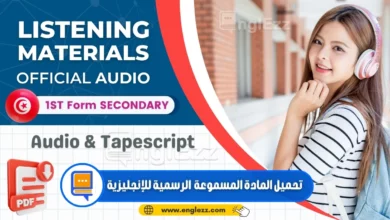


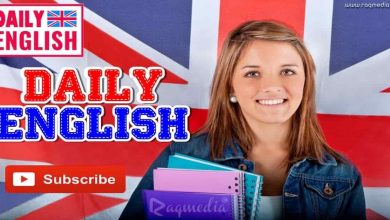
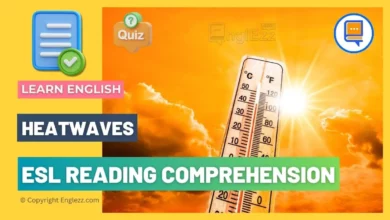


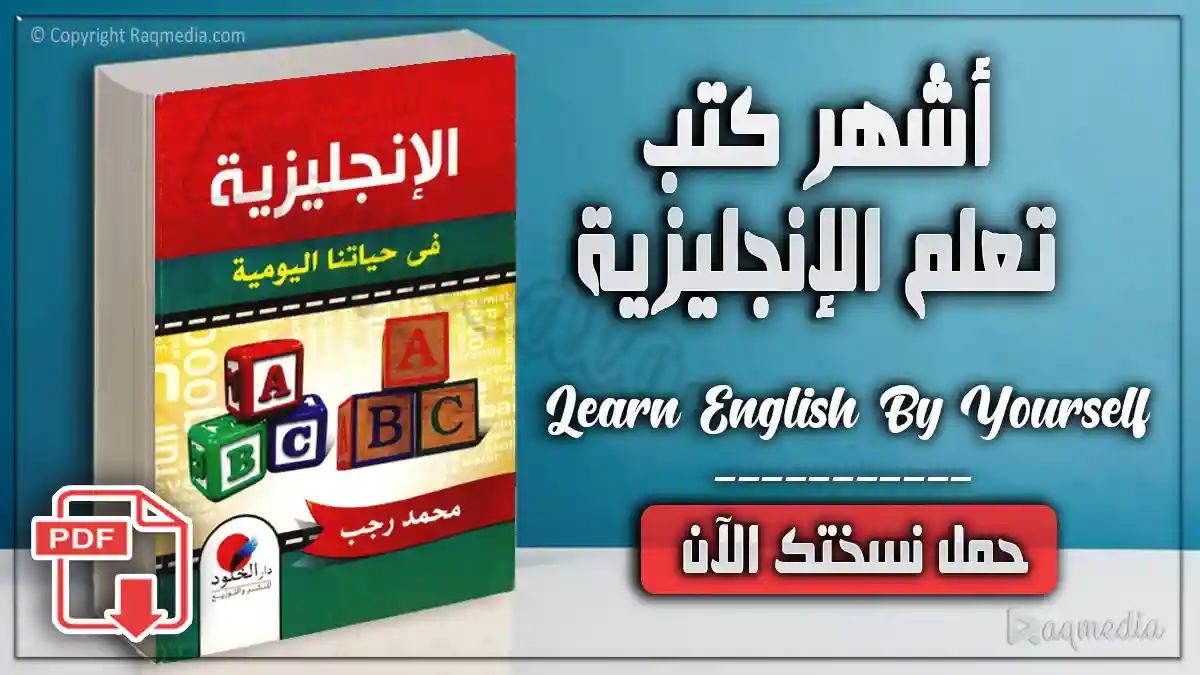
Unlock the beauty of poetry with our guide on the 50 most common American poetry terms! 📚 Whether you’re a seasoned poet or just starting out, understanding these terms can elevate your appreciation for the art of verse. 🌟Ready to dive in? Don’t forget to like and follow
@EnglEzz for more enriching content. Check it out here:
.
.
https://www.englezz.com/50-essential-poetry-english-terms/
englezz #vocabulary #linguistics #poetry #poetrycommunity #literaryterms #education #languagelearning #learnenglish